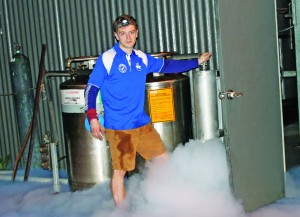Draytons Wines fined over $200,000 for blast that killed Trevor Drayton, Eddie Orgo
DRAYTON’S Family Wines has been fined more than $200,000 over the explosion that claimed the lives of winemaker Trevor Drayton and welder Eddie Orgo.
Workcover NSW prosecuted Drayton’s, and Mr Orgo’s employer, Perfab Engineering, in the District Court’s criminal jurisdiction for two breaches each of the Occupational Health and Safety Act.
Major changes proposed for the WorkCover system in South Australia
SAWIA is undertaking extensive work on the alternative Workers Compensation scheme for South Australia, ensuring the State Government takes into account the wine industry’s views prior to the tabling of legislation. Overall the package of changes seems to be reasonable, albeit that some additional changes would further assist wine producers and grape growers. The focus is on a more sustainable system (ie dealing with the unfunded liability) and a levy rate that is far more comparable to interstate systems which should result in a much more competitive system.
By way of background, Premier Jay Weatherill introduced major policy reform that claims to benefit workers, reduce business costs and cut red tape, with the tabling of Return to Work Bill 2014 and the South Australian Employment Tribunal Bill 2014 in State Parliament on 6 August.
On 8 August, SAWIA circulated a Notice to Members setting out a brief summary of the key proposed changes including amendments to income maintenance, eligibility, return to work obligations, dispute resolution and the application of common law.
These changes will see the introduction of an entirely new Act, which the Government asserts will save registered businesses in South Australia more than $180 million per year. The Return to Work Bill will replace the current Workers Compensation and Rehabilitation Act 1986. The Employment Tribunal Bill will replace the Workers Compensation Tribunal and is intended to provide quicker access and faster dispute resolutions. The Bills will be debated when Parliament resumes from 16 September.
SAWIA will continue to closely monitor the progress of the Bills and keep members informed as this matter progresses. For more information, contact Egon Schwidder on 8222 9273 or egon@winesa.asn.au.
When management is a bully
The Fair Work Act introduced new anti-bullying provisions at the start of the year. Here’s a reminder of what does and doesn’t constitute an offence by co-workers or, in particular, management.
Source: HRMonline
Postgraduates: Strong Earnings and Employment
According to Graduate Careers Australia’s (GCA) newly released Postgraduate Destinations 2013 report, 92.4 per cent of new postgraduates were in some form of employment shortly after completing their degrees (see Table E1a in the related spreadsheet). The report is based on GCA’s 2013 Australian Graduate Survey (AGS).
Almost one-in-ten (9.7 per cent) were working on a part-time basis while continuing to seek full-time employment with 82.7 per cent in full-time employment, adding to the total of 92.4 per cent. A further 7.5 per cent of recent postgraduates were without work and seeking a full-time position at the time of the AGS. This figure is up slightly from 6.3 per cent in 2012 and 6.6 per cent in 2011 but notably higher than 3.6 per cent in 2006 (see Table E1a in the related spreadsheet).
Postgraduate studies continue to play an important role in the education and training of Australians. Between 1999 and 2012, the number of people completing postgraduate awards increased by 124 per cent. In 2012, more than a third of completing domestic higher education students had studied at a postgraduate level.
GCA Executive Director, Dr Noel Edge, said “Postgraduate study meets a variety of student needs, from updating old skills and re-skilling to adding vocational qualifications to a generalist degree in order to stand out from the increasing number of bachelor degree graduates in the Australian workforce.”
The median reported salary for all postgraduates was $79,000 ($85,000 for males and $72,000 for females (see Table 9 in the report)). Differences in salaries for males and females at this high level of aggregation are generally a result of factors such as differing field of education enrolment patterns, and differing types of employer and occupation.
In the wider Australian workforce, Australian Bureau of Statistics data gathered at around the same time as the AGS was conducted suggest that postgraduates had an unemployment rate of between 2.6 and 3.5 per cent, compared to 7.8 per cent for those with no post-secondary qualifications and 5.7 per cent for the entire workforce.
Further information and comment
Copies of the recently released Australian Graduate Survey report, Postgraduate Destinations 2013, can be downloaded from the GCA website: http://www.graduatecareers.com.au/mediacentre/ags-2013-reports/ (password: PGDMEDIA).
For comment please contact Bruce Guthrie on (02) 6367 5347 or Graeme Bryant on (03) 9605 3710.
Court pays out $1 million to worker for dismissal without reasonable notice
The NSW Supreme Court has awarded over $1 million to an employee who was dismissed without reasonable notice.
Susanna Ma worked as an accounts manager for businesses related to logistics company Expeditors International for 24 years.
Ma was 49 years old when she was dismissed and had an accounting team of more than 12 people reporting to her. MORE
Scholarships and awards provide pathways to global opportunities

A range of annual scholarships and awards acknowledge outstanding wines, people, producers and suppliers who contribute to Australia and New Zealand’s burgeoning wine industries. Stephanie Timotheou looks at the major opportunities, why they exist and how beneficial they are.
THERE are many quiet achievers in the wine and viticulture business.
That’s why there are a wide range of scholarships and awards received year after year as a way of recognising innovation and excellence within the industry.
Wine bodies, research institutes, universities and organisations offer scholarships to encourage people in the industry to travel, visit other regions and experience life as a winemaker or viticulturist outside their comfort zones.
Below is an overview of what the nation’s peak industry body Wine Australia offers, as well as opportunities provided by Charles Sturt University, one of the largest tertiary institutions in the country.
INDUSTRY SCHOLARSHIPS
Wine Australia
Wine Australia has been involved in a number of scholarships since its inception in the ’80s.
The body’s regional director for Australia, Asia and emerging markets Aaron Brasher says it awards scholarships to top students across the UK, North America, Asia, Europe and Australia through the Wine & Spirit Education Trust (WSET).
In addition to supporting the WSET and its eight scholarships, Wine Australia is involved in the Sommelier Immersion Program, the Trade Immersion Program and the Daniel Pontifex Memorial Trust in awarding the Pontifex Scholarship each year.
“The annual scholarship allows the recipient to work as a sommelier in a London restaurant, further his or her knowledge and gain a global view of the wine industry,” Brasher says.
“Wine Australia also awards the Pontifex Scholarship to a member of the UK trade to visit Australia and become great ambassadors for Australian wine when they return home.”
Wine Australia’s Sommelier Immersion Program (SIP) is about “influencing influencers” and making sure they have an intimate knowledge of Australian wine regions.
“Education is key to success and the more we can educate people about Australian wine, the more they are going to support it – whether it’s retail or simply educating consumers so they buy Australian wine with the knowledge they are getting the best in the class.”
Charles Sturt University
The National Wine & Grape Industry Centre (NWGIC) is one of Charles Sturt University’s (CSU) research centres and funds one full-time Higher Degree by Research (HDR) scholarship each year.
The aim of this scholarship is to provide financial support to HDR students in Masters by Research and Research Doctorates whose research proposal is aligned with the objectives of the university’s research centres.
“These HDR scholarships have been running for many years and are offered through the university’s six research centres which can receive up to 200 applications annually,” NWGIC administrative officer Robyn Harrington says.
“The biggest benefit of receiving a scholarship from CSU is the stipend is sufficient to give an individual full financial assistance while studying.”
Applications are taken from eligible students intending to undertake research which is closely linked to the centre’s objectives and research in the fields of wine science, grapevine pathology, grapevine physiology and wine consumer preference.
For a full list of scholarships CSU offers visit www.csu.edu.au/nwgic/research.
INDUSTRY AWARDS
The wine industry is particularly rewarding when it comes to wine shows but also plays host to major award nights recognising outstanding suppliers, winemakers and top drops.
For the industry:
Suppliers to the industry have the opportunity to be recognised at the annual Wine Industry Suppliers’ Association (WISA) Supplier of the Year Awards.
WISA chief executive Matthew Moate says there are limited opportunities for suppliers in the wine industry to be recognised for their excellence in supply, despite much of the innovation and improvement in wine quality and profitability attributed to them.
“These awards are important to the industry as competition helps drive innovation and a competitive industry is generally a profitable and efficient one,” he says.
Moate says the biggest benefit of winning such an award is recognition by peers in the industry, credibility and the ability to strengthen relationships with existing customers.
“It also allows a supplier to approach potential clients with greater confidence and expectation of success,” he adds.
Five awards are given at the event covering a range of categories including export, innovation and environment and sustainability.
“Great wines just don’t happen – there are many people, products, services and companies that make a contribution,” he says.
For the young guns:
The Wine Society’s Lydia Stjepanovic runs the Young Winemaker of the Year Awards which is open to both Australian and New Zealand winemakers.
Now in its 14th year, the awards have become nationally regarded as accolades recognising significant achievements of young winemakers.
The Wine Society says the future of the wine industry lies firmly in the hands of its young guns and needs to provide tangible opportunities to help these winemakers develop their profile within the industry.
The Wine Society Young Winemaker of the Year program comprises three distinct and highly prized awards.
These include the Wine Society Young Winemaker of the Year, the Young Winemaker of the Year Finalists’ Choice and the Young Winemaker of the Year Supporters’ Choice.
The equivalent for young viticulturists is the New Zealand Young Viticulturist of the Year Award.
For winemakers and viticulturists:
Each year Gourmet Traveller presents the awards for Winemaker of the Year and Viticulturist of the Year.
Chairman of judges Peter Forrestal says both awards have gained significant prestige over the years with past winners receiving recognition among their peers and extensive publicity within the industry.
“The key to the compelling lure of the awards is the stories our writers have told of the men and women whose dedication, attention to detail, technical know-how and artistic flair has enabled them to transform the humble Australian grape into some of the world’s most compelling wines,” he says.
“As we announce another batch of finalists it’s worth reflecting on what we perceive as their importance to the Australian wine industry.
“Their greatest wines have enriched our lives with memories of their finest bottles and their attention to detail in the vineyard and winery has enabled them to craft wines of rare quality which is what the judges look for.”
For top drops:
One of the most renowned wine shows in Australia is the Sydney International Wine Competition (SIWC).
The SIWC is an independent, self-funded and food-oriented wine competition that also offers a free, web-based wine information service to consumers.
“While we don’t sell wine, our website does offer deal-direct winery contact details for all award-winning wines so consumers can find where to purchase them,” competition director Warren Mason says.
Events such as the SIWC, which has been running since 1982, helps sell award-winning wines and raise a greater awareness of a particular brand.
Each year the competition accepts 2000 entries for judging.
Mason says the purpose of the competition is to offer information that assists consumers make smart purchasing decisions.
“We offer objective, individual commentary on each wine by at least six of our international judges to help consumers choose quality, food-friendly, award-winning wines at different price points, likely to meet personal preferences and enhance the enjoyment of their dining and lifestyle experiences,” Mason says.
“The biggest benefit of entering your wine into a competition like the SIWC is that it generates sales, recognition and respect.At the SIWC more than 300 awards are up for grabs each year.
WHY APPLY?
In terms of both scholarships and awards, Brasher says being recipients of either provide multiple opportunities.
“There are plenty of opportunities out there – if you’re a young industry person who has ambition and drive, look at what is out there and apply and continue applying even if you’re unsuccessful in the first instance.”
To include your event, award or wine show on the Winebiz calendar email wid@winetitles.com.au or phone the Winetitles office on 61 8 8369 9500.
Contacts:
Aaron Brasher, P: 61 2 9361 1227
Robyn Harrington, P: 61 2 6933 2940
Matthew Moate, P: 61 (0)409 783 221
Lydia Stjepanovic, P: 61 1300 729 657
Peter Forrestal, P: 61 8 9341 1107
Warren Mason, P: 61 2 4757 4400
Generation Success launches new content for young workers, parents and employers
Generation Success is an industry led initiative aimed at drawing employer’s attention to youth unemployment in Australia, and providing practical tips and advice to support employers, young people as well as parents and educators.
The Generation Success webpage was updated early August with new links and resources, including interactive videos and quizzes to support young workers, their parents and educators, and employers looking to support young people into employment. Visit employment.gov.au/GenerationSuccess.
Top tips for keeping your workplace out of danger
FARMING and agriculture are among the most dangerous fields of work in Australia.
But while the wine industry is part of this ‘risky business’, fatalities have remained low with just three deaths reported in 10 years to 2012.
That’s according to independent statutory agency Safe Work Australia which is responsible for improving occupational health and safety and workers’ compensation arrangements across the nation.
While the number of deaths in the wine industry are minor when compared to other industries, there were more than 3000 serious claims accepted for compensation between 2000 and 2012.
Safe Work Australia says the number of claims decreased from a high of 350 in 2005-06 due to greater awareness of health and safety in the workplace.
“Businesses have a legal obligation to health and safety in the workplace to minimise the risk to their workers,” the company tells Grapegrower & Winemaker.
“This includes reducing hazards from plants, machinery, chemicals and manual tasks.
“It’s important that policies are put in place to ensure wine businesses can continue to meet these obligations and operate safely and efficiently.”
RESPONSIBILITIES OF AN EMPLOYER
An employer has the primary duty of care under the Work Health and Safety Act (WHS).
This duty requires the employer to ensure workers are not exposed to health and safety risks arising from the business.
“They must do this by eliminating risks to health or safety or, if this is not practicable, minimising risks as much as possible,” Safe Work Australia says.
In meeting this duty, the employer must ensure the following:
• The provision and maintenance of a working environment that is safe and without risks to health, including safe access to and from the workplace
• The provision and maintenance of plant, structure and systems of work that are safe and do not pose health risks (e.g. providing effective guards on machines and regulating the pace and frequency of work)
• The safe use, handling, storage and transport of plant, structure and substances
• The provision of adequate facilities for the welfare of workers
• The provision of information, instruction, training or supervision to workers
• The health of workers and the conditions of the workplace are monitored to prevent injury or illness.
The WHS laws have been adopted in all jurisdictions except WA and Victoria, though the current laws in these states include similar requirements.
These guidelines apply to crushers or de-stemmer augers, must pumps, bottling equipment and any other plant or chemical used in the workplace.
IDENTIFYING AND PREVENTING A SAFETY HAZARD
Some of the most common hazards faced by workers in vineyards and wineries include operating equipment on hillsides and uneven terrain, pushing and lifting heavy bins, barrels, pumps, hoses or mixers, using pruning shears and picking knives, working with hazardous chemicals and entering confined spaces.
A worker or employer can prevent most workplace injuries and illnesses if they identify workplace hazards and take steps to control them.
This involves eliminating the hazard entirely or minimising the risks as much as possible, which can be done by:
• Selecting appropriate safety features when purchasing or replacing equipment
• Modifying work processes or equipment
• Developing and implementing safe work procedures for hazardous tasks
• Ensuring workers use appropriate protective equipment and follow safe work procedures
PUTTING REGULATIONS INTO PRACTICE
Most Australian wineries and vineyards have standard operating procedures and policies in place to prevent health and safety hazards.
McLaren Vale’s d’Arenberg says the company is committed to providing a safe system of work for its employees and contractors.
As well as having a range of processes in place, a number of employees across all departments have attended training sessions to attain their WH&S Certificate III.
The company continues to host regular internal and external training courses for its employees to ensure they are kept up-to-date with work health and safety practices.
Among a range of health and safety projects already in place at d’Arenberg, the winery has implemented:
• Multiple eye wash and shower stations
• Upgraded stairwells and handrails
• Catwalks over concrete open fermenters
• A dedicated winery chemical mixing shed
• Electric forklifts to reduce emissions in closed areas
• Thermal and fire sensor alarm systems
One of the bigger players in the market, Treasury Wine Estates (TWE), also takes work health and safety seriously.
Corporate affairs manager Sue Rana says traffic, in particular, is a hazard which is often overlooked.
“We have a wide variety of vehicles operating in all parts of our business – tractors, harvesters, trucks, forklifts and cars driven by sales representatives as they visit customers,” she says.
“These vehicles are all essential to our work but can be hazardous without the right training and site management systems.”
Within TWE’s wine production business, all vineyard and winery sites have traffic management plans (TMP) in place.
These plans define how drivers operate vehicles on site and how pedestrians are required to behave when around those vehicles.
“The TMP sets the pathway for vehicles to traverse the site including loading areas for forklifts, pedestrian exclusion zones and crossings and driver safety zones,” Rana says.
PLANNING PROVIDES THE GROUND RULES
“The plan defines the speed limit and location for stop and give-way signs and sets the requirement for pedestrians and drivers when outside their vehicle to wear hi-visibility clothing and safety boots.”
Rana says it is vital to have a traffic standard that everyone on site is aware of and complies with to ensure a safe and productive operation.
“Having all stakeholders involved in the development of these plans increases understanding of our overall traffic safety requirements and commitment to compliance,” she says.
“In developing these plans we consult with our workforce, external carriers who visit our sites and best practice standards in other comparable industries.”
REPORTING AN ACCIDENT, HAZARD OR INJURY
Safe Work Australia says workers should report accidents and other incidents (including things such as near misses) to their supervisor and report a hazard that may endanger others in the future, a problem with equipment, a violation of the regulations or other legal requirements.
Australian government – both the commonwealth and the states and territories – also retain the responsibility for regulating and enforcing all the work health and safety laws operating in their jurisdiction.
The contact details for each state and territory regulators can be found at the link: www.safeworkaustralia.gov.au/sites/swa/about/who-we-work-with/pages/who-we-work-with.
Contact:
Safe Work Australia
P: 1300 551 832
E: info@swa.gov.au
Sue Rana
P: 61 8 8301 5880
E: sue.rana@tweglobal.com
Tash Stoodley
P: 61 8 8329 4825
E: tash@darenberg.com.au
SA winery Kahlon Estates fined $68,000 for workplace safety breaches that cost employee his leg
A SOUTH Australian winery has been fined $68,000 for a workplace safety breach that resulted in an employee’s leg being amputated.
Kahlon Estate’s Wines Pty Ltd pleaded guilty in the Industrial Magistrates Court to failing to ensure the safety of employee Sukhwant Virk in April 2011.
The good, the bad and the casual

VINTAGE might be over for another year but that doesn’t mean vineyard and winery owners can sit back and relax just yet. The industry heavily relies on the use of casual staff to see each harvest through, which means employers must seek suitable candidates to lend a helping hand year after year.
Bibber International marketing and program manager Pamela Campusano says the right time to hire a casual depends on each winery’s necessities and starting date of vintage.
“We notice in wineries where vintage starts in early January they normally start looking for staff at the end of August or the beginning of September, however we have wineries looking for staff until late February and sometimes even March,” she says.
“The best time to get staff is before Christmas and New Year; however we understand things are not always ideal so we try to have casual staff available from August until the end of February.
“Even if wineries leave the hiring process to the last minute or the staff they were counting on decide not to work with them anymore, we can help them.”
She says Bibber International ensures it has available, reliable and professional casual staff ready to take on any job until March.
ADVANTAGES AND DISADVANTAGES
Hiring casual staff is a great way for winery and vineyard owners to get the assistance they require during vintage. The main benefit is most job seekers are young, enthusiastic workers and know the job will have a specific start and end date, but Campusano says wineries need to be careful during the hiring process.
“It’s always a good idea to hire people who are planning to develop a career in the wine industry, rather than backpackers looking for jobs just for money without appreciating the experience,” she says.
“Passionate causal staff will always be better than somebody only looking to make money.”
Disadvantages depend on the selection process a winery implements to hire casual staff. Campusano says unskilled or inexperienced staff are a gamble for any winery and the lack of commitment to the job may result in serious problems.
“We have heard so many stories of unreliable casual staff – that could be because the winery next door offers them two dollars extra per hour and they just leave or because they have a big night and don’t show up to work next day,” she adds.
Bibber International ensures all applicants have the appropriate qualifications and/or experience in the wine industry and can speak English before offering their services.
CASUAL EMPLOYEES AT BIRD IN HAND
South Australia’s Bird in Hand winery regularly employs casual staff to work the vintage each year. Michael Best from the UK was one of 12 casuals hired to see this vintage through and assisted production winemaker Peter Ruchs during his three-month contract with the company. He began work at Bird in Hand in mid-February and stayed until the end of vintage in May.
Bird in Hand communications manager Fiona Nieuwenhuizen says the company’s experience in hiring casual staff has been good so far but it can sometimes be difficult to secure the best candidates for the job.
“Candidates can often apply for various jobs and then decide from all their job offers which option will suit them best,” she says. “This means you don’t always get the staff you first offer the position to, but we do have processes in place to ensure we reference check each candidate so we can source experienced vintage casuals.”
RECRUITMENT OPTIONS
There are many benefits to utilising cost-effective job sites and employment agencies that source and screen candidates locally and internationally.
For employers who prefer to manage their own recruitment process, Winejobs, Australia’s leading wine industry jobs site, provides maximum candidate reach at a cost-effective price. Promoted in print publications and online, the site regularly posts casual, part-time or full-time positions and key international roles, catering for all types of people seeking work in the industry.
Bibber International arranges overseas workers for seasonal work within Australia during harvest. The company specialises in wine and agriculture placements and offers assistance with visa requirements for those travelling to Australia from abroad.
“For each applicant we provide a CV, autobiography, reference letter and a YouTube video so the employer can check their English level and personality,” Campusano says.



